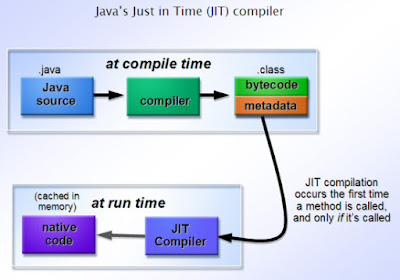JIT Compiler
The Just-In-Time (JIT) compiler is a component of the Java Runtime Environment that improves the performance of Java applications at run time. Java programs consists of classes, which contain platform neutral bytecode that can be interpreted by a JVM on many different computer architectures. At run time, the JVM loads the class files, determines the semantics of each individual bytecode, and performs the appropriate computation. The additional processor and memory usage during interpretation means that a Java application performs more slowly than a native application. The JIT compiler helps improve the performance of Java programs by compiling bytecode into native machine code at run time.
Nothing in the JVM affects performance more than the compiler, and choosing a compiler is one of the first decisions made when running a Java application whether you are a Java developer or an end-user.
The JIT compiler is enabled by default, and is activated when a Java method is called. The JIT compiler compiles the bytecode of that method into native machine code, compiling it "just in time" to run. When a method has been compiled, the JVM calls the compiled code of that method directly instead of interpreting it. Theoretically, if compilation did not require processor time and memory usage, compiling every method could allow the speed of the Java program to approach that of a native application.
JIT compilation does require processor time and memory usage. When the JVM first starts up, thousands of methods are called. Compiling all of these methods can significantly affect startup time, even if the program eventually achieves very good peak performance.
Compiler Type:
- Client-side compilers
- Server-side compilers
- Tiered compilers
When a method is chosen for compilation, the JVM feeds its bytecode to the Just-In-Time compiler (JIT). The JIT needs to understand the semantics and syntax of the bytecode before it can compile the method correctly. To help the JIT compiler analyze the method, its bytecode are first reformulated in an internal representation called trees, which resembles machine code more closely than bytecode. Analysis and optimizations are then performed on the trees of the method. At the end, the trees are translated into native code. The JIT compiler can use more than one compilation thread to perform JIT compilation tasks. Using multiple threads can potentially help Java applications to start faster.
The Code compilation by JWT consists of the following phase:
Inlining is the process by which the trees of smaller methods are merged, or "inlined", into the trees of their callers. This speeds up frequently executed method calls.
Local optimizations analyze and improve a small section of the code at a time. Many local optimizations implement tried and tested techniques used in classic static compilers.
Control flow optimizations analyze the flow of control inside a method (or specific sections of it) and rearrange code paths to improve their efficiency.
Global optimizations work on the entire method at once. They are more "expensive", requiring larger amounts of compilation time, but can provide a great increase in performance.
Native code generation processes vary, depending on the platform architecture. Generally, during this phase of the compilation, the trees of a method are translated into machine code instructions; some small optimizations are performed according to architecture characteristics.



Thanks for taking time to discuss about this technology. I love to learn more about this topic. If possible. as you gain experience update your blog with more information? It is extremely helpful for me.
ReplyDeletedotnet training in chennai
Best DOT NET Training institute in Chennai
This is an awesome post for the people who are in search of this technology.
ReplyDeleteYour blog is really mind blowing and the design is really first class.
dot net training in chennai
dot net course in chennai
salesforce training in chennai
sas training in chennai
spoken english classes in chennai
dot net training in velachery
dot net training in tambaram
dot net training in anna nagar
Great post! This is very useful for me and gain more information, Thanks for sharing with us.
ReplyDeleteArticle submission sites
Guest posting sites
Nice it was superb I am always searching online for articles that can help me. There is obviously a lot to know about this. I think you made some good points in Features also. Keep working, great job!
ReplyDeleteDot Net Training in Chennai | Dot Net Training in anna nagar | Dot Net Training in omr | Dot Net Training in porur | Dot Net Training in tambaram | Dot Net Training in velachery
mmorpg oyunlar
ReplyDeleteinstagram takipçi satın al
Tiktok jeton hilesi
TİKTOK JETON HİLESİ
saç ekimi antalya
referans kimliği nedir
İnstagram Takipçi Satın Al
Mt2 Pvp Serverler
instagram takipci